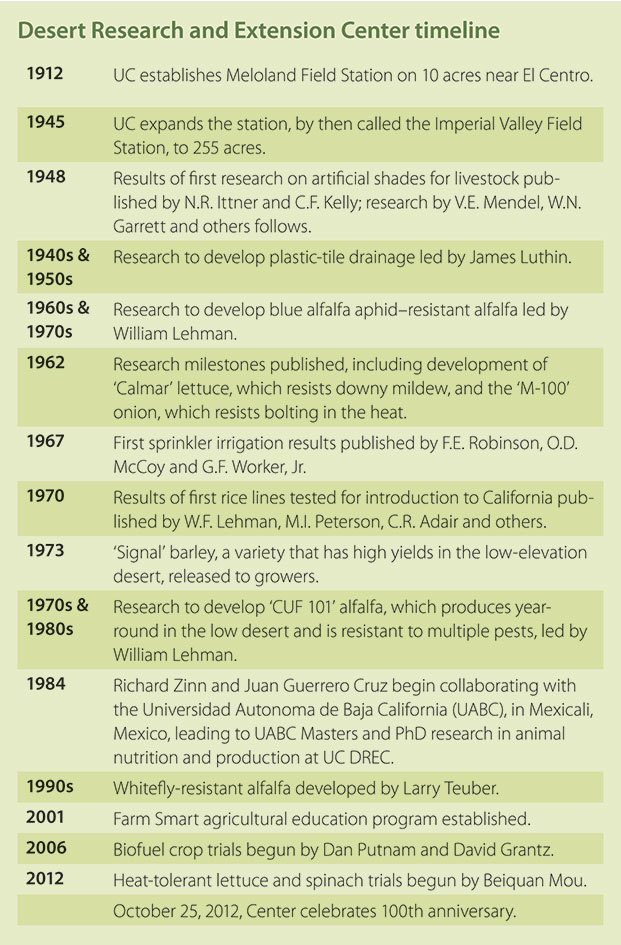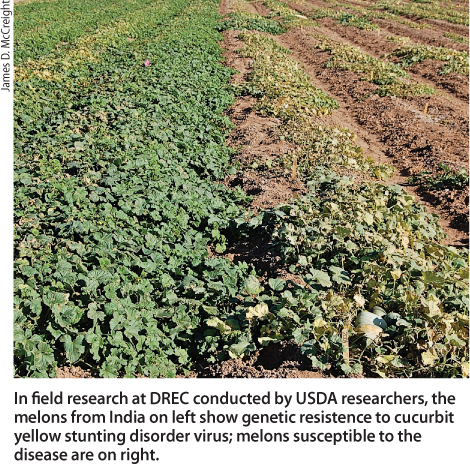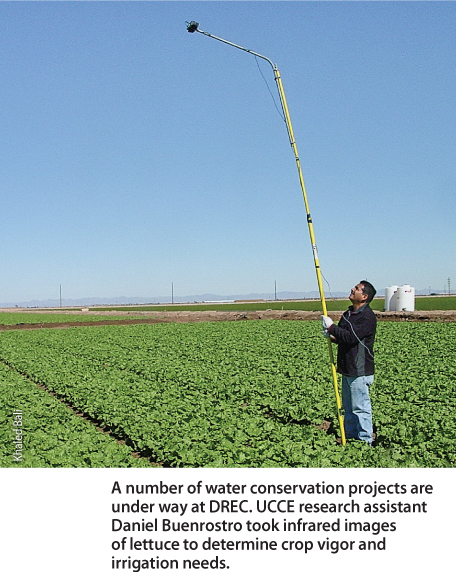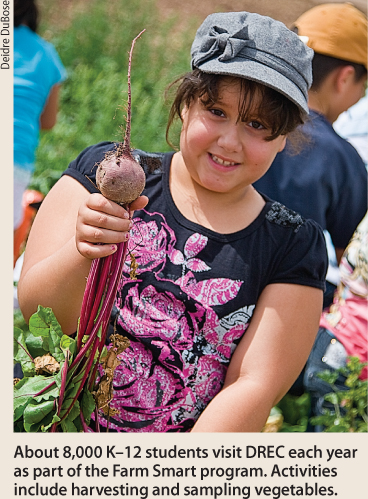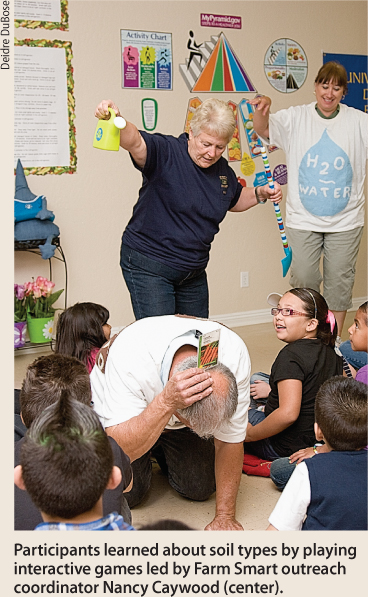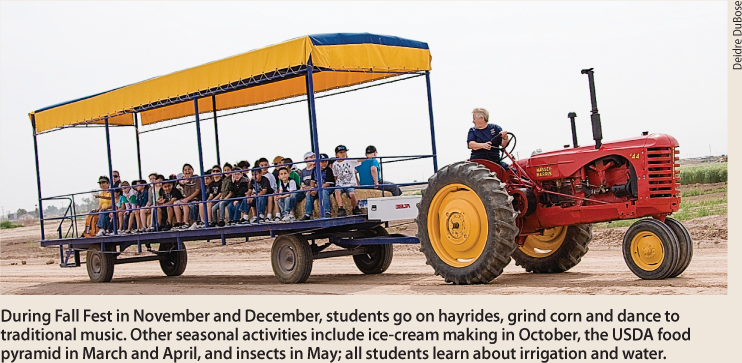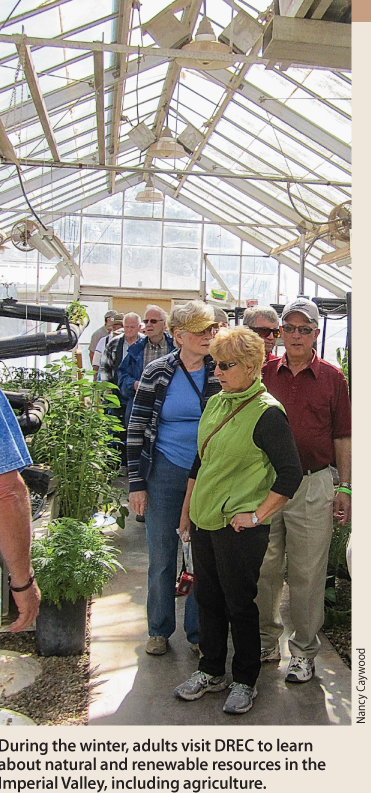All Issues
UC Desert Research and Extension Center celebrates 100 years
Publication Information
California Agriculture 66(4):122-126.
Published online October 01, 2012
PDF | Citation | Permissions
NALT Keywords
Summary
Three-quarters of surveyed ranchers who would sell land if they lost Williamson Act tax benefits predicted that it would be developed for nonagricultural uses.
Full text
When the UC Desert Research and Extension Center (UC DREC) was established in the Imperial Valley in 1912, water from the Colorado River was so available that dairies were plentiful in this desert region, along with feedlots for steers born to milk cows and fields of alfalfa to feed all those cattle.
While most of the dairies are long gone and the water supply has been tightened to meet urban demands on the Colorado River, the Imperial Valley's cattle feedlots and field crops have grown. In addition, farmers there have expanded into high-value crops such as winter vegetables and melons.
“The Imperial Valley is one of the largest agricultural areas in California,” says Bill Frost, director of UC Agriculture and Natural Resources (ANR) Research and Extension Center (REC) system, which has nine centers spanning the state to support research tailored to local needs. “DREC is right in the middle of the desert, enabling the University to focus on locally relevant critical issues.”
Agriculture in the Imperial Valley
Initially called the Meloland Field Station and later the Imperial Valley Field Station, UC DREC was the first addition to what became the ANR REC system. The 255-acre center is in the middle of an agricultural region called the low desert that encompasses California's Imperial and Coachella valleys, Arizona's Yuma Valley and Mexico's Mexicali Valley.
Walter Eugene Packard established UC's Meloland Field Station in the Imperial Valley in 1912 and served as superintendent until 1917. He lived in this house.
As a former Colorado River floodplain, the Imperial Valley has deep, rich soil. But rainfall averages less than 3 inches per year and summer temperatures can reach 120°F.
The winters, however, are sunny and mild, with highs in the 80s°F, allowing the year-round production that has helped make Imperial a top-10 agricultural county in California. The county had nearly $2 billion in gross agricultural production in 2011, and its top commodity groups are livestock, valued at more than $400 million; field crops, including alfalfa, wheat and sudangrass, at nearly $520 million; and melons and vegetables, including lettuce, broccoli and onions, at more than $900 million. About two-thirds of the vegetables eaten nationwide during winter are grown in Imperial County.
Throughout the 1920s and 1930s, the Imperial Valley Experiment Farm was staffed by one agronomist/superintendent. This picture of summer legumes was taken in 1924.
“We have perfect weather for winter vegetables. It's not too hot and hardly rains, so you can harvest all the time — the weather never gets in the way,” says UC DREC superintendent Fernando Miramontes, who started there 33 years ago as a part-time field-worker and now oversees all research projects.
The UC Desert Research and Extension Center is located in the heart of the Imperial Valley in southeastern California, on 255 acres. The area was formerly Colorado River floodplain, so its soils are deep and rich, but there is very little rainfall. Farming in this desert environment presents unique challenges.
UC DREC research contributions
DREC's research facilities include greenhouses, a plant- and soil-processing laboratory, an insect-rearing facility, a fully automated sprinkler area and a research feedlot cattle facility. The center has an annual operating budget of about $800,000 and research operations budget of over $500,000; with the help of more than a dozen administrative and field research support staff, scientists from UC as well as the USDA Agricultural Research Station in Salinas, more than 25 research projects are currently under way.
Over the past century of changes, UC DREC researchers have helped Imperial Valley farmers meet the many challenges of desert agriculture, including lack of water, extreme summer heat, and rampant pest insects that devour crops and spread diseases. The center's major contributions (see timeline) include:
-
Developing cattle feeds and shade structures to enhance feedlot production during the summer, when high temperatures hinder livestock weight gain.
-
Developing plastic-tile drainage systems to maintain soil productivity by flushing salt from the root zone.
-
Increasing the yields and pest resistance of desert-grown crops, from alfalfa and wheat to melons and lettuce.
-
Testing thousands of rice lines from around the world for introduction to California.
In addition, today's UC DREC researchers are helping farmers prepare for the future by, for example, exploring the potential of sugar cane and other crops for biofuel feedstocks and by creating crop varieties that are adapted to climate change.
Feedlot cattle nutrition, care and production
UC DREC is a national leader in feedlot cattle research, with one of the largest university facilities, including a 700-head feedlot, more than 100 pens, a metabolism barn and a feedmill. Led by Richard Zinn, a UC Davis professor of animal science, the research focuses on optimizing feedlot cattle health and management in the extreme heat of the low desert summers.
In addition to helping cattle producers in the Imperial Valley, Zinn and colleagues collaborate with researchers at the Universidad Autonoma de Baja California (UABC), in Mexicali, Mexico, which is just over the border from UC DREC. Beginning with short courses in animal science at the UABC in 1984, this collaboration has grown to include Masters and PhD animal production programs there. Such programs offer students UABC faculty advisors coupled with research training and thesis work in UC DREC's comprehensive feedlot facilities. The collaboration has also led to UC DREC's participation in developing and strengthening postgraduate animal science programs at several other Mexican universities.
Water conservation and quality
Because rain is so scarce, the Imperial Valley depends entirely on the Colorado River for irrigation water. While this water flowed freely for decades, today growers must contend with competing demands from Southern California cities.
“Water transfers between agricultural and urban areas put increased pressure on growers to conserve to meet the needs of the future,” says Khaled Bali, UC DREC interim director and UC Cooperative Extension Imperial County irrigation/water management advisor. So far, transfer agreements have claimed about one-tenth the water once used for irrigation in the Imperial Valley.
The bulk of the irrigation water goes to field crops, which account for 80% of the 500,000 cultivated acres in Imperial County; most of the crops are primarily flood irrigated. UC DREC water conservation projects include lining irrigation canals, automating flood irrigation and developing strategies for using less water during the summer. “We are working to match water with crop needs,” says Bali, who has worked at UC DREC for more than 20 years.
However, water conservation is complicated by local environmental factors. “One of the biggest issues is salinity,” Bali says. “It's so hot that lots of the irrigation water evaporates, adding 7 tons of salt per acre per year.” Most crops, particularly vegetables, are salt sensitive. But getting rid of salt means flushing the soil with even more water. “We're working to decrease runoff and optimize deep percolation, so there will be enough water to flush salts but not so much that there's waste,” Bali says.
Another difficulty is that agricultural wastewater is critical to the Salton Sea, which provides important bird habitat. “The Imperial Valley drains naturally into the Salton Sea, so more water conservation means less water for the Sea,” Bali says. The influx of relatively fresh agricultural water is needed to counterbalance the salt-concentrating effects of evaporation, and the Salton Sea is already about 30% saltier than the ocean.
Low desert alfalfa
Alfalfa is the Imperial Valley's biggest water user, consuming more than a third of the available irrigation water. It is also the region's most extensive and valuable field crop, with nearly 120,000 acres in production and valued at $120 million in 2011. “Alfalfa has been important in the Imperial Valley from the very beginning,” says Dan Putnam, a UCCE agronomist and forage specialist based at UC Davis. “There were thousands of small dairies in the early 1900s, and most grew alfalfa.” Today, most of the region's alfalfa is shipped to dairies in Chino, San Bernardino County, which is among the state's largest milk-producing areas.
One of UC DREC's most important contributions is a variety of alfalfa developed in the 1970s by agronomist William Lehman. Called CUF 101, this alfalfa variety resists the blue alfalfa aphid and grows through the winter in the low desert rather than going dormant. “This saved the alfalfa industry because the aphid was decimating the crop in California,” Putnam says. “CUF 101 also increased yields, revolutionizing alfalfa production in California as well as in Argentina, Australia, South Africa and the Middle East.”
Putnam, who has worked on alfalfa for more than 20 years, tests varieties statewide to optimize local yields. “UC DREC is a terrific environment for testing for heat tolerance and long production seasons,” he says. Thanks to winter growth in the Imperial Valley, today's alfalfa varieties produce up to 12 harvests per year, which is four times that in some parts of the state.
Developing new crop lines
UC DREC's winter growing season also speeds the development of new commercial crops. “It cuts the time of line development in half,” Miramontes says. “We plant the lines in the winter, and our collaborators plant them in the summer.”
Long-term projects include a 30-year collaboration on barley triticale with Canada's Alberta Agriculture and Rural Crop Development Center and a 35-year collaboration on carrots with the USDA. “We test more than 1,250 carrot varieties from all over the world in just an acre,” Miramontes says.
UC agronomist George F. Worker served at DREC from 1953 to 1985. In the early 1980s, he pollinated sorghum for field trials.
Pest-resistant melons
But year-round production also has the downside of favoring crop pathogens such as powdery mildew and pest insects such as whiteflies, which feed on plant sap and spread diseases. “The Imperial Valley has had lots of trouble with white-flies — there's always something for them to eat,” says Jim McCreight of the USDA Agricultural Research Station (ARS) in Salinas, who has done field trials at UC DREC for a decade. “In some years, there can be such clouds of whiteflies that you have to be careful how you breathe.”
Since the late 1970s, two new types of whiteflies have plagued the Imperial Valley, introducing four viral diseases. In addition, a new race of powdery mildew appeared in 2003. To help growers keep up with such constantly emerging pests and diseases, McCreight develops melons and other crops that are naturally genetically resistant. He discovered a cucumberlike cousin of cantaloupe from India that resists the new powdery mildew and three of the whitefly-transmitted viruses. He plans to breed these traits into the sweet cantaloupe preferred here. Maintaining crop resistance takes ongoing work, however. “It's common for pathogens to overcome resistance that's based on just one gene,” McCreight says.
In field research at DREC conducted by USDA researchers, the melons from India on left show genetic resistence to cucurbit yellow stunting disorder virus; melons susceptible to the disease are on right.
Biofuel crops
Several UC DREC researchers are evaluating the potential of high-yield crops for biofuel production in the Imperial Valley region, including switchgrass, sugarbeets and sugar cane. The most common biofuel worldwide is ethanol, which can be made by fermenting sugar from crop plants.
“One of the roles of the University is to test new possibilities,” UCCE's Putnam says. “We provide independent data so growers can make informed decisions.” Growth trials began in 2006, and so far sugar cane may be a promising candidate for low desert biofuel production.
Leafy greens and climate change
In another forward-looking project, plant geneticist Beiquan Mou of the U.S. Department of Agriculture's Agricultural Research Service in Salinas is working at DREC to create lettuce and spinach that can withstand the higher temperatures expected with climate change. Balmy winters have helped make Imperial Valley lettuce, valued at nearly $370 million in 2011, the leading commodity in the county. However, while the Imperial Valley is the nation's “winter salad bowl,” the majority of California lettuce is now grown in the Salinas Valley, near Monterey, which currently has an ideal climate for this cool-season crop, with highs in the 60s and 70s°F. In addition, the Central Valley produces lettuce during the spring and fall.
“Climate change could change all of that,” Mou says. “Some say the Salinas Valley could become a dust bowl.” At temperatures above 80°F, lettuce tends to develop black tips and go to seed (bolt), and heat also makes its seeds go dormant.
Mou identified likely heat-tolerant varieties by growing them in the laboratory at 113°F last year and is now field-testing them at UC DREC and in the Central Valley. The results are already promising, including varieties that germinate at 100°F and do not bolt even at 110°F.
The benefits of heat-tolerant leafy greens go beyond preparing for climate change. “We also hope to extend the growing seasons in the low desert and Central Valley,” Mou says. “This would save growers on land costs.” Rental rates for farmland in these hot valleys are only one-fifth of those in Salinas Valley, which exceed $1,500 an acre per year.
A number of water conservation projects are under way at DREC. UCCE research assistant Daniel Buenrostro took infrared images of lettuce to determine crop vigor and irrigation needs.
Just as it has over the last century, UC DREC will continue providing research and outreach to meet the needs of Californians, from desert crop and livestock production to water conservation and environmental protection. “The farm economy is really taking off — Imperial Valley crops are at record highs right now,” UC DREC interim director Bali says. “We want to one-make sure we keep supporting farmers in the future.”
Farm Smart offers hands-on experience, insight into where food comes from
One of the highlights of UC DREC is an agricultural education program called Farm Smart, which was developed by former elementary school teacher Nancy Caywood. Also a farmer's daughter, Caywood got into agricultural literacy when she asked her 1st- and 2nd-grade students where food came from. “They said ‘from the grocery store’ and that really bothered me,” Caywood recalls. “So I asked if I could bring my kids to the farm.” The resulting field trips prepared Caywood for her next career as the Farm Smart outreach coordinator at UC DREC.
About 8,000 K-12 students visit DREC each year as part of the Farm Smart program. Activities include harvesting and sampling vegetables.
Established in 2001, Farm Smart provides K-12 agricultural outreach and education programs for just $3 per student. Funding also includes $50,000 annually from the Imperial Irrigation District as well as support from the Imperial County Farm Bureau and local seed companies. “The community makes this happen,” Caywood says.
With a team of volunteers that includes her husband, Alan Robertson, Caywood offers more than 150 daylong agricultural education programs to nearly 8,000 students each year. The curriculum is aligned with the content standards for California public schools, covering topics including health and nutrition, bees and pollination, and natural and renewable natural resources. Designed to be fun as well as informative, the programs emphasize hands-on activities, from harvesting and eating winter crops to milking artificial cows and making butter, and also include hayrides and sing-alongs.
Participants learned about soil types by playing interactive games led by Farm Smart outreach coordinator Nancy Caywood (center).
During Fall Fest in November and December, students go on hayrides, grind corn and dance to traditional music. Other seasonal activities include ice-cream making in October, the USDA food pyramid in March and April, and insects in May; all students learn about irrigation and water.
During January and February, Caywood offers a similar outreach program to the “snowbirds,” retirees who flock from cold climates to the Imperial Valley. Called the Winter Visitor program, this Farm Smart component enrolls about 3,000 participants.
During the winter, adults visit DREC to learn about natural and renewable resources in the Imperial Valley, including agriculture.
“Most people just don't know much about agriculture,” Caywood says. “We help them learn where their food comes from.”







